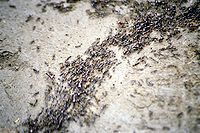
Photo from wikipedia
Flexible robotic cells are used to produce standardized items at a high production speed. In this study, the scheduling problem of a flexible robotic cell is considered. Machines are identical… Click to show full abstract
Flexible robotic cells are used to produce standardized items at a high production speed. In this study, the scheduling problem of a flexible robotic cell is considered. Machines are identical and parallel. In the cell, there is an input and an output buffer, wherein the unprocessed and the finished items are kept, respectively. There is a robot performing the loading/unloading operations of the machines and transporting the items. The system repeats a cycle in its long run. It is assumed that each machine processes one part in each cycle. The cycle time depends on the order of the actions. Therefore, determining the order of the actions to minimize the cycle time is an optimization problem. A new mathematical model is presented to solve the problem, and as an alternative, a simulated annealing algorithm is developed for large-size problems. In the simulated annealing algorithm, the objective function value of a given solution is computed by solving a linear programming model which is the first case in the literature to the best of our knowledge. Several numerical examples are solved using the proposed methods, and their performances are evaluated.
Journal Title: Advances in Mechanical Engineering
Year Published: 2018
Link to full text (if available)
Share on Social Media: Sign Up to like & get
recommendations!